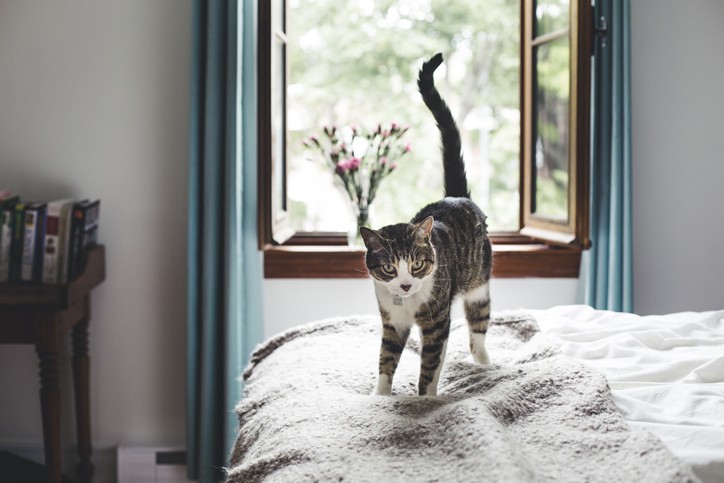
What Your Cat’s Body Language is Telling You
If you’ve ever found yourself wondering what your cat’s body language means, you’re not alone. Many cat owners have trouble understanding the subtle meanings behind their cats’ movements and body language, but this skill is an important one to work on.
In the article below, you’ll find out more information about some of the most common types of cat body language to be on the lookout for. The next time you spot your feline friend showing you some of these signs, you’ll know more about what they mean and what to expect from your cat, too.
Cat Body Language: Face and Ears
Here are some tips of what to watch for in your cat’s face and ears.
Relaxed Positions
If the face and ears look relaxed, then the cat is relaxed! A cat with neutral ears and a neutral expression is content and unbothered by anything.
Wide, Round Eyes
If your cat’s eyes get wide and their pupils are very round, this could mean they are playing or hunting. On the other hand, if their eyes are wide and pupils become slits, this means your cat is angry and may attack in a moment.
Ears Back
Ears flat back against the head signify a cat who is either angry or very irritated. A cat showing this body language may attack soon or may give a warning scratch or bite first. It’s a good idea to back off if you see this body language.
Eyes Slowly Closing
If your cat is comfortable and their eyes are slowly closing and then opening again, they may be dozing off. However, if they are doing this while making eye contact with you, then you should feel honored! Eye contact with slow eye closing is the closest cats come to saying “I love and trust you.”
Cat Body Language: Posture
A cat’s posture can tell us a lot about how they are feeling. Keep a close watch to see what your cat is trying to tell you.
Curled Up
If your cat is curled up in a circle and sleeping soundly, they are very comfortable. If they are nestled into a blanket or has folded paws underneath their body, these are also signs of being comfortable and happy. Cats may sometimes sleep in very peculiar positions, but if your cat is comfortable, it’s best not to bother them!
Sitting or Standing Normally
If your cat is sitting and watching you, or if they are standing up and keeping an eye on the events happening around them, this is normal as well. Your cat is content or possibly slightly alert, but isn’t agitated or upset about anything.
Hunched
A cat who is hunched is trying to make themselves look as small as possible. This happens when cats are frightened, sick, or injured. If your cat is hunching and hiding, you may need to take them to the veterinarian, as something could be wrong.
Back Raised
If your cat is raising their back while facing you, this may mean they are angry and about to attack. A cat who arches their back like this is on the offensive and feels threatened in some way. Kittens, however, may do this while playing, and it is usually accompanied by a small hop forward.
Cat Body Language: Tail
Yes, your cat can communicate using their tail. Here are different tail positions to look for when watching your pet.
Upright
An upright tail pointed into the air or pointed toward you is a sign of a friendly, happy cat. If your cat comes trotting out to meet you at the door when you come home, tail held high, this means they are happy to see you.
Down
A cat who keeps his tail down between their legs or low to the ground may be in pain or sick, especially if combined with a hunched posture. However, if you see this behavior in your cat along with alert ears and wide eyes, they may be hunting or playing instead.
Puffed Up
A tail that is held straight up and puffed out to make itself look bigger is a sign of a cat who is either angry, startled, or playing. You’ll need to look at your cat’s other body language to figure out why their tail is puffed up.
Twitching
Twitching can mean a lot when it comes to cat tails. A cat who is watching a toy (or another cat) with a twitching tail is probably about to pounce, usually in play. However, if you’re petting your cat and they doesn’t like it, they may twitch his tail back and forth to tell you to stop.
What is Your Cat Trying to Tell You?
The longer you are around cats, the more likely you’ll be to learn their body language well. It takes some time and practice, so first-time cat owners may not always get it right, and that’s okay. It is important for you to work patiently with your cat and take time to get to know their body language as you bond with them.
If you have any other questions about your cat’s body language, talk to your vet. The vet may be able to give you some recommendations and information specific to your individual cat’s needs. Use the online form to book an appointment with your Boston Veterinary Clinic vet!